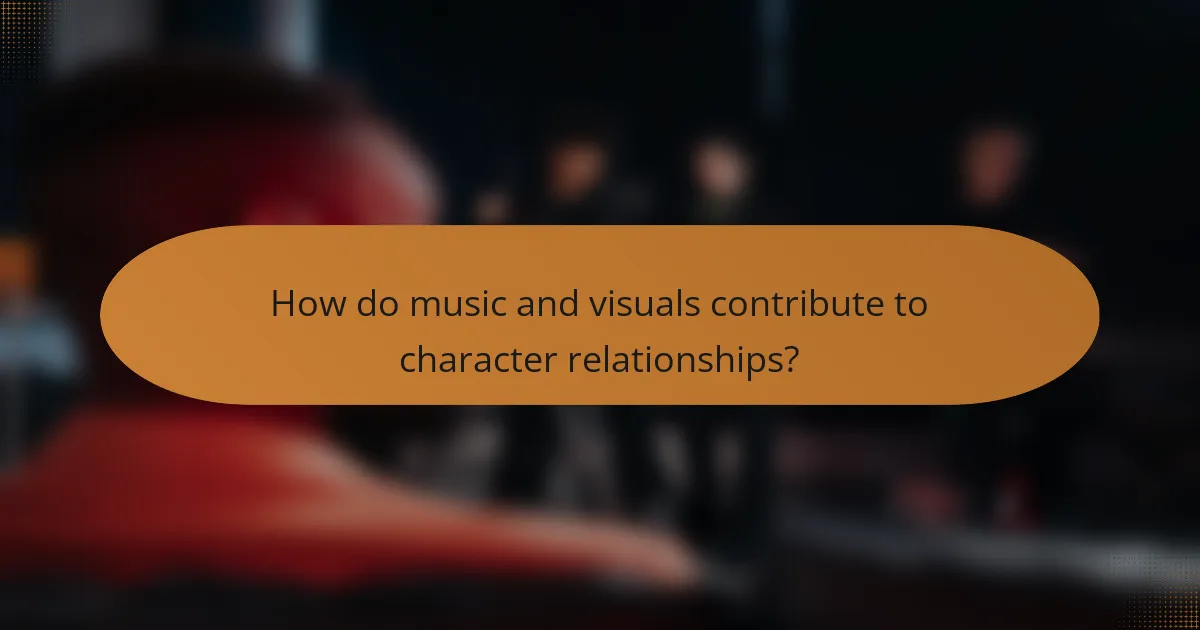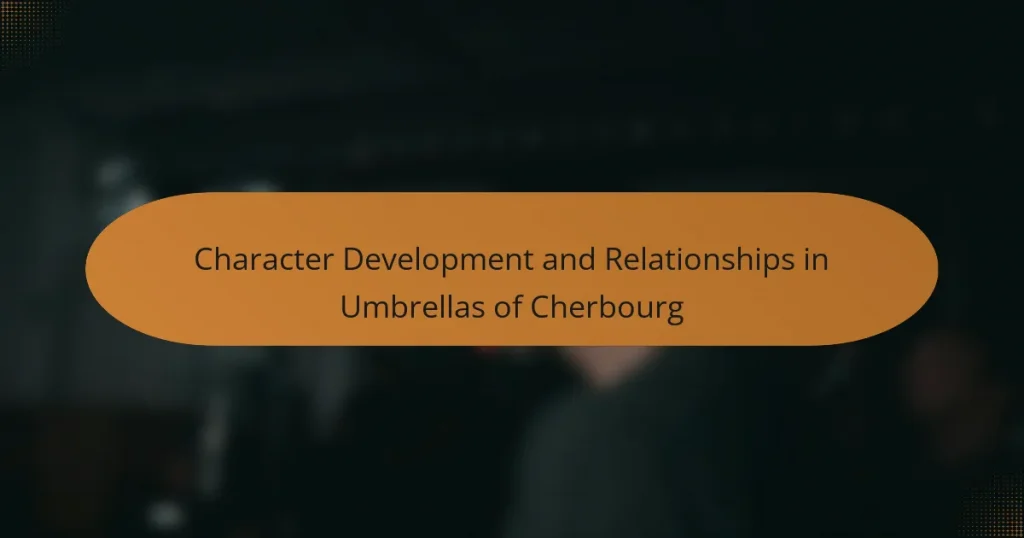The article focuses on character development and relationships in the film “Umbrellas of Cherbourg.” It highlights the emotional and relational growth of the main characters, Geneviève and Guy, illustrating how their experiences with love, loss, and external circumstances shape their identities. The narrative explores key relationships, including Geneviève’s connection with her mother and Guy’s subsequent relationship with Madeleine, emphasizing themes of sacrifice and the impact of societal expectations. Additionally, the article discusses how music and visual elements enhance character dynamics, deepening the audience’s understanding of their emotional states and interactions throughout the film.

What is Character Development in Umbrellas of Cherbourg?
Character development in “Umbrellas of Cherbourg” focuses on the emotional and relational growth of the characters. The film portrays the journey of Geneviève, who evolves from a naive young woman to a more complex individual shaped by love and loss. Her relationship with Guy illustrates the impact of external circumstances on personal choices. The narrative emphasizes how their separation leads to significant changes in their characters. Guy’s character also develops as he faces the realities of war and responsibility. The film uses music and visual storytelling to enhance these character arcs. Each character’s growth is intertwined with the themes of love, sacrifice, and the passage of time. The emotional depth of the characters is critical to the film’s impact and resonance with audiences.
How do the characters evolve throughout the film?
The characters in “Umbrellas of Cherbourg” evolve through personal growth and emotional experiences. Geneviève transforms from a naive young woman into a more mature individual facing life’s realities. Her relationship with Guy deepens, but ultimately shifts as circumstances change. Guy, initially idealistic, confronts the harshness of war and responsibility. His character matures as he navigates love and loss. The evolution of both characters highlights their struggles with choices and consequences. Their journeys reflect the impact of external factors on personal development. The film’s narrative structure emphasizes these changes through music and dialogue, reinforcing their emotional arcs.
What key experiences shape their development?
Key experiences that shape character development in “Umbrellas of Cherbourg” include love, loss, and socio-economic challenges. The romantic relationship between Geneviève and Guy serves as the foundation for their emotional growth. Their love is tested by external circumstances, including war and financial instability. Geneviève’s decision to marry Roland, despite her feelings for Guy, highlights the impact of societal expectations. Guy’s struggle with military service further complicates his personal journey. These experiences create a rich tapestry of emotional depth and character evolution. The film illustrates how relationships are influenced by both personal choices and broader societal factors.
How do their relationships influence their growth?
In “Umbrellas of Cherbourg,” relationships significantly influence character growth. The main characters, Geneviève and Guy, experience profound changes due to their romantic connection. Their love drives Geneviève to make life-altering decisions, such as her choice to marry another man for security. This decision highlights the tension between love and practicality, showcasing her internal conflict.
Guy’s relationship with Geneviève shapes his aspirations and emotional state. After their separation, he struggles with loss and seeks solace in the military. This journey reflects his growth as he confronts his feelings and adapts to a new reality.
The interplay of these relationships illustrates how love can lead to personal transformation. Characters evolve as they navigate their desires and responsibilities. Their growth is intricately tied to their emotional bonds, demonstrating the impact of relationships on individual development.
Why is character development significant in the narrative?
Character development is significant in the narrative because it drives the emotional engagement of the audience. Well-developed characters create relatable experiences and foster empathy. In “Umbrellas of Cherbourg,” the evolution of characters reflects their personal struggles and growth. This development enhances the narrative’s depth and complexity. Viewers connect more deeply with characters who face challenges and change. Research indicates that character arcs significantly impact audience investment in stories. A study by Green and Brock (2000) shows that character development influences emotional responses and overall enjoyment of narratives.
What themes emerge from the characters’ journeys?
Themes that emerge from the characters’ journeys include love, sacrifice, and the passage of time. The characters experience deep emotional connections that highlight the complexities of love. Sacrifice is a recurring theme, as characters make difficult choices for the sake of others. The passage of time is evident in how relationships evolve and change. These themes are reflected in the characters’ decisions and their consequences. For example, Geneviève’s choice to leave Guy demonstrates the theme of sacrifice. Additionally, the film portrays the impact of time on their dreams and aspirations. Overall, these themes intertwine to shape the narrative and character arcs.
How do the characters reflect societal issues of the time?
The characters in “Umbrellas of Cherbourg” reflect societal issues of the time through their struggles with love, class, and war. Geneviève represents the challenges faced by women in post-war France. Her desire for stability and love highlights the societal pressures on women to secure their futures. Guy, as a working-class man, embodies the economic struggles of the era. His conscription into the Algerian War represents the impact of conflict on personal lives. The relationship between Geneviève and Guy illustrates the tension between personal desires and societal expectations. The film’s setting in a changing France mirrors the transition from traditional values to modernity. Their choices reveal the limitations imposed by social class and gender roles. Thus, the characters serve as a lens through which the societal issues of the 1960s can be examined.

What are the main relationships in Umbrellas of Cherbourg?
The main relationships in “Umbrellas of Cherbourg” include Geneviève and Guy, Geneviève and her mother, and Guy and Madeleine. Geneviève is deeply in love with Guy, but their relationship is tested by circumstances. Geneviève’s mother disapproves of Guy, wanting her daughter to marry a wealthier man. After Guy goes to war, Geneviève is forced to move on and eventually marries Roland, a richer suitor. Guy, heartbroken, later meets Madeleine, who helps him heal. These relationships illustrate themes of love, sacrifice, and the impact of external factors on personal connections.
How do the relationships between characters drive the plot?
Relationships between characters drive the plot by creating conflict and resolution. These dynamics shape character motivations and decisions. For example, the love triangle between Geneviève, Guy, and Roland propels the narrative forward. Geneviève’s choices reveal her internal struggle between love and duty. Guy’s actions are influenced by his feelings for Geneviève, affecting his life decisions. The tension between characters leads to pivotal moments that change their trajectories. As characters interact, their relationships evolve, impacting the overall storyline. This interplay of relationships keeps the audience engaged and invested in the outcome.
What role does love play in the relationships?
Love serves as the foundational element in relationships, significantly influencing emotional bonds. It fosters connection, trust, and intimacy between individuals. Love promotes understanding and empathy, allowing partners to navigate challenges together. In “Umbrellas of Cherbourg,” love drives character decisions and actions, impacting their development. The film illustrates how love can lead to both joy and heartache. These dynamics highlight love’s dual role in shaping relationships. Research shows that love enhances relationship satisfaction and longevity. Strong emotional connections are often linked to better mental health outcomes.
How do misunderstandings affect character interactions?
Misunderstandings create tension and conflict in character interactions. They can lead to miscommunication and emotional distance. Characters may misinterpret intentions or feelings, resulting in hurt and resentment. This dynamic often escalates conflicts within the narrative. For example, in “Umbrellas of Cherbourg,” misunderstandings drive a wedge between characters. The lack of clear communication affects their relationships significantly. Studies show that miscommunication is a common theme in character-driven stories, reinforcing the importance of dialogue. This illustrates how misunderstandings are pivotal in shaping character development and interactions.
What types of relationships are portrayed in the film?
The film “Umbrellas of Cherbourg” portrays romantic relationships, familial bonds, and friendships. The primary romantic relationship is between Guy and Geneviève, characterized by deep love and eventual separation. Their love is tested by external circumstances, including war and financial struggles. Familial relationships include Geneviève’s bond with her mother, who disapproves of her romance with Guy. This dynamic adds tension and influences Geneviève’s decisions. Friendships are also depicted, particularly through Guy’s interactions with his friends, who provide support and perspective. Overall, the film explores the complexities of love, obligation, and the impact of external factors on personal connections.
How do familial relationships impact the characters?
Familial relationships significantly impact the characters in “Umbrellas of Cherbourg.” The dynamics between family members shape their motivations and decisions. For instance, Geneviève’s relationship with her mother influences her choices regarding love and duty. Her mother’s expectations create internal conflict for Geneviève. Similarly, the absence of a strong paternal figure affects Guy’s character development. He struggles with his sense of identity and responsibility. The film portrays how familial pressures can lead to emotional turmoil. This contributes to the overall themes of love and sacrifice. The characters’ interactions with their families ultimately drive the narrative forward.
What is the significance of friendship in the story?
Friendship in “Umbrellas of Cherbourg” serves as a crucial element for character development. It highlights the emotional connections between characters. This bond influences their decisions and life choices. For instance, the friendship between Geneviève and her mother shapes Geneviève’s perspective on love and responsibility. Their interactions reveal the complexities of loyalty and sacrifice. Additionally, friendships in the story create a contrast to romantic relationships. They provide support during challenging times, emphasizing the importance of companionship. Overall, friendship enriches the narrative by showcasing personal growth and emotional depth among characters.

How do music and visuals contribute to character relationships?
Music and visuals significantly enhance character relationships by conveying emotions and subtext. In “Umbrellas of Cherbourg,” the use of a continuous musical score reflects the characters’ inner feelings. The color palette and visual composition further emphasize their emotional states. For example, bright colors represent hope and love, while darker tones indicate despair. This synergy between music and visuals deepens the audience’s understanding of character dynamics. Specific scenes illustrate how music underscores pivotal moments, creating tension or intimacy. Overall, the combination of these elements shapes the narrative and character interactions powerfully.
What role does the film’s score play in character development?
The film’s score plays a crucial role in character development by enhancing emotional depth. It reflects the characters’ inner feelings and struggles. For example, the use of specific musical themes aligns with character arcs. When a character experiences joy, the score becomes uplifting. Conversely, moments of sadness are underscored by melancholic melodies. This contrast helps audiences connect with the characters’ journeys. Additionally, the score can foreshadow character decisions and transformations. By intertwining music with narrative, the film deepens the viewer’s understanding of each character’s motivations. Overall, the score is integral to portraying character evolution throughout the film.
How do specific songs reflect character emotions?
Specific songs in “Umbrellas of Cherbourg” reflect character emotions through their lyrics and melodies. Each song conveys the inner feelings of the characters during pivotal moments. For instance, “I Will Wait for You” expresses longing and hope, mirroring the protagonist’s desire for reunion. The use of minor keys often signifies sadness or despair, highlighting emotional turmoil. Conversely, upbeat melodies can indicate happiness or excitement, aligning with joyful moments. The emotional weight of the songs is further emphasized by the context in which they are performed. This alignment between music and emotion enhances the audience’s understanding of character development. The integration of song and narrative creates a profound emotional experience.
What visual elements enhance the portrayal of relationships?
Color palettes enhance the portrayal of relationships. They evoke emotions and set the mood. Warm colors often signify love and passion. Cool colors can represent sadness or distance. Composition also plays a role in visual storytelling. Close framing can create intimacy between characters. Wider shots may depict isolation or conflict. Lighting techniques further influence perceptions. Soft lighting can enhance tenderness, while harsh lighting may highlight tension. Symbolic imagery, such as umbrellas, reinforces themes of protection and vulnerability. These visual elements collectively enrich the audience’s understanding of relationships in “Umbrellas of Cherbourg.”
What lessons can be learned from the character dynamics?
Character dynamics in “Umbrellas of Cherbourg” teach the importance of communication and emotional honesty. Characters often face misunderstandings due to a lack of open dialogue. For instance, Geneviève and Guy’s relationship suffers from unexpressed feelings and societal pressures. Their inability to discuss their dreams leads to emotional distance. Additionally, the film illustrates how external factors, like war and economic struggles, impact personal relationships. The consequences of choices made by characters highlight the need for accountability in relationships. Ultimately, the character dynamics demonstrate that vulnerability can foster deeper connections.
How can viewers apply these insights to their own relationships?
Viewers can apply insights from “Umbrellas of Cherbourg” to their own relationships by recognizing the impact of communication. Open dialogue fosters understanding and emotional connection. Observing the characters’ struggles highlights the importance of expressing feelings. Viewers can learn to prioritize honesty in their interactions. The film illustrates how unaddressed emotions can lead to misunderstandings. By reflecting on these dynamics, individuals can improve conflict resolution skills. Embracing vulnerability can strengthen relational bonds. Ultimately, these insights encourage proactive engagement in personal relationships.
The main entity of the article is “Character Development and Relationships in Umbrellas of Cherbourg.” The article provides an in-depth analysis of how characters like Geneviève and Guy evolve emotionally and relationally throughout the film, highlighting key experiences that shape their development, such as love, loss, and societal pressures. It examines the significance of relationships in driving the plot, the impact of misunderstandings, and the role of music and visuals in enhancing character dynamics. The article also discusses the broader themes of sacrifice, societal issues, and the lessons viewers can apply to their own relationships.


